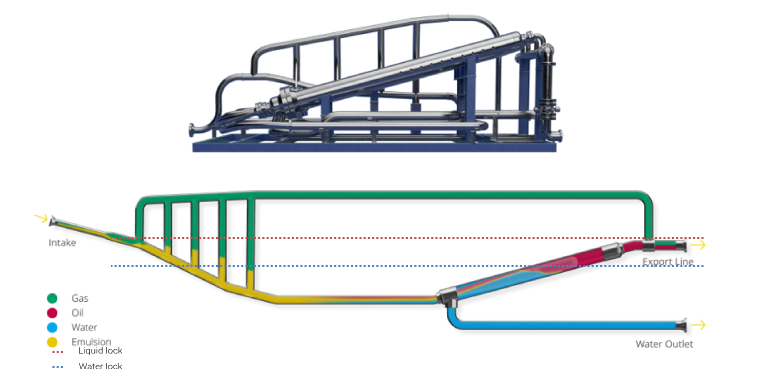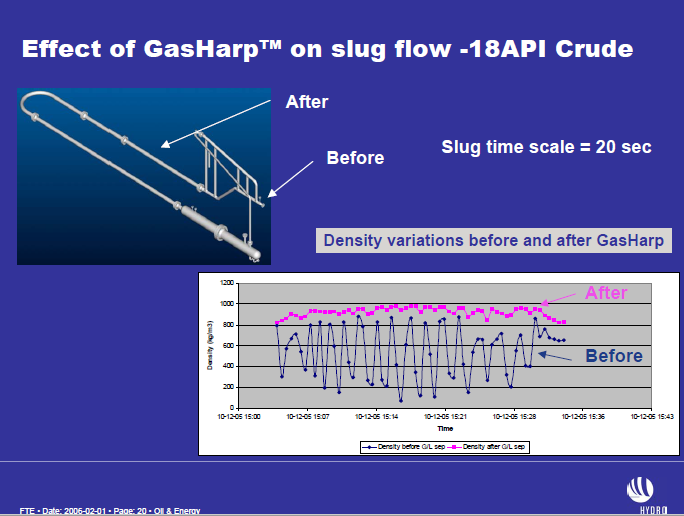How do we handle the energy in the process stream coming from the reservoir?Answer - The Gas Harp
Introduction
Producing from a reservoir that contain pressurized fluids will cause transport issues. One significant issue is the flow behavior and slug flow is often the dominating flow pattern. Slug flow will dominate because the volume of gas become significant when the transport pressure is reduced on the journey from the reservoir to the platform or FPSO..
Seabed Separation has decided to utilize the Gas Harp technology designed by Norsk Hydro now Equinor) which is already in commercial use by Petrobras on their Marlim field in Brazil. The Gas Harp is designed to suppress the liquid slug energy and separate the free gas from the well stream. After separation the gas from the well stream the gas is bypassed the DPS system. The DPS system is then left with the task of separating the oil and the water and in the tilted DPS separation units where the water is decanted from the well stream, leaving only clean oil to be exported to a platform or FPSO. The oil is comingled with the bypassed gas coming from the gas export prior to being exported.
Principle of operation
The illustration (figure 1) below show the DPS system as designed to integrate the gas harp in cooperation with the other components. The well stream enters the gas harp consisting of five vertical pipes providing a larger volume in which the excess volume of liquids will occupy depending on the inflow velocity (volume m3/h). As seen on the below illustration (figure 1) the green colored section is occupied by the gas which is a fluid that is compressible. When the liquid slug enters the gas harp and starts to fill up the vertical pipes the gas will be compressed, absorbing the energy and suppress the slug energy. The liquids that moves up and down in the vertical pipes might be compared with a piston in a gas shock absorber. The energy in the slug is captured.
.
On figure 2 below the effect using the gas harp for slug suppression is shown. The vertical pipe configuration provides a slug absorbing volume and in combination with the compressibility of the gas give a unique combined function. When the gas is removed from the liquid the velocity drops significantly in the downstream pipeline, hence providing very good conditions for separation of the oil and the water in the horizontal pipeline. The horizontal pipeline work as a pre-separation/conditioning unit upstream the tilted DPS units.
The specific gas harp design that Seabed Separation uses, is based on pipe size 8’’. Having a gas harp with 8’’ pipe size the recommended throughput is 60.000 BPD. This throughput is not limiting the function of the gas harp or providing any upset. A CFD analysis was conducted based on a data set from an OLGA simulation on an existing field. This case was purposely selected due to severe terrain slug phenomenon. The CFD analysis showed that the gas harp could handle a liquid volume equal to 105.000 BPD. Exceeding that volume, the liquid and the liquids will fill the entire gas harp, and the liquids will again spill over into the gas pipeline and comingle with the clean oil. It is important to note that immediately after the slug volume ended the gas harp resumed to normal function.
The DPS system can also be operating on a gas condensate field, as well as an oil field, where huge gas rates are dominating. The system set-up will only have to be adjusted by having two parallel gas harps are installed. The use of two gas harps are to accommodate the gas velocities and to establish and maintain the function for separation and removal of the water that follow the gas stream.
Conclusion
The gas harp has proven to be a robust and self-regulating unit with no moving parts, that adapts to the changing operating conditions without any need for regulation or intervention.

